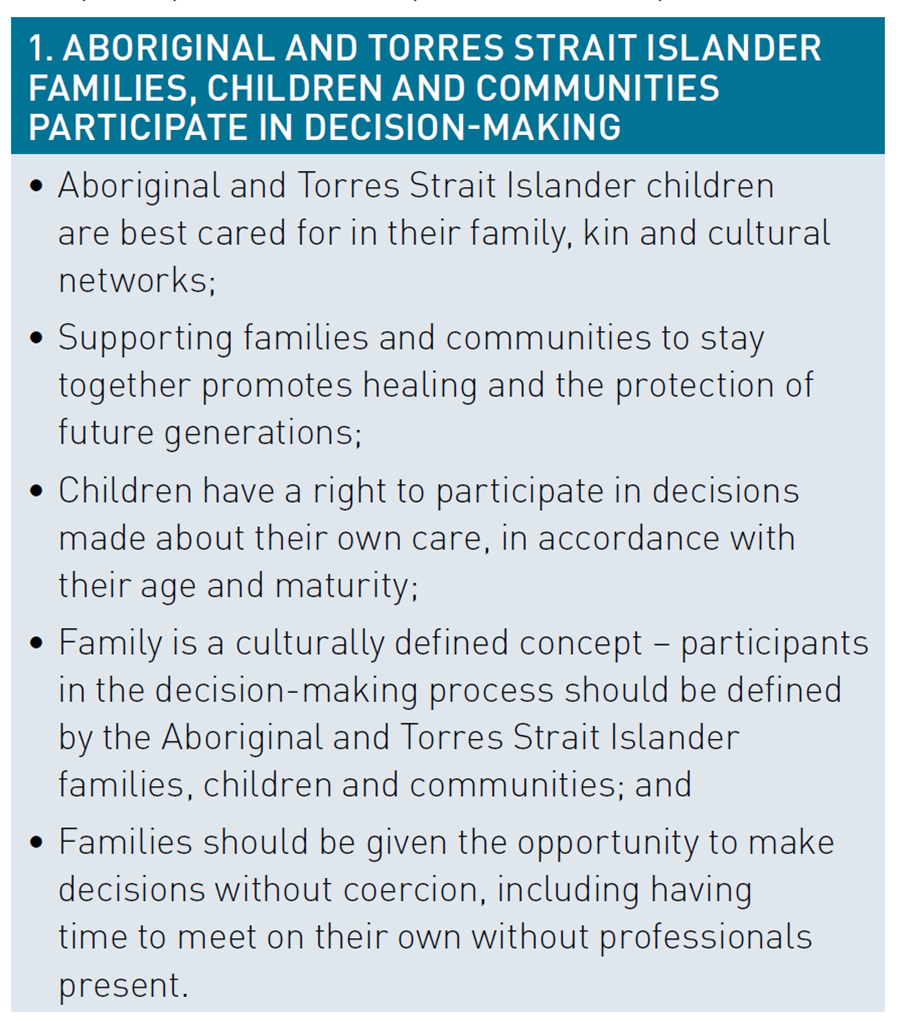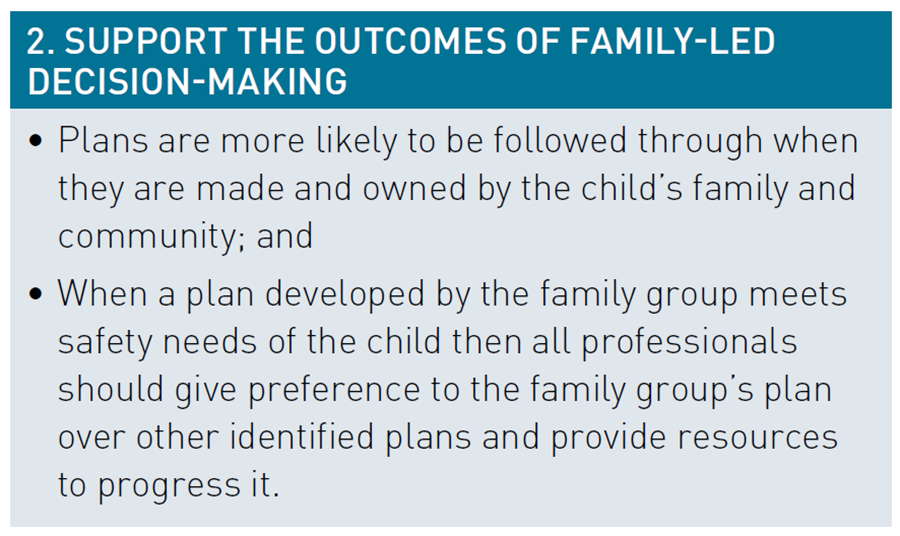‘Aboriginal family-led decision-making draws on traditional Indigenous consultative methods to create safe spaces where families can make decision in the best interest of Aboriginal and Torres Strait Islander children, grounded in culture and family’
- Secretariat of National Aboriginal and Islander Child Care (SNAICC), 2019.
What is Aboriginal and Torres Strait Islander family-led decision making?
SNAICC (2019) identifies that Aboriginal and Torres Strait Islander family-led decision making should aim to:
- promote self-determination, participation and shared decision making at different phases of the child protection continuum
- deepen families’ understanding of child protection processes and the reasons for the involvement of child protection services
- empower families to make informed choices about the child’s best interest and put decision-making around child protection concerns in the hands of the child’s immediate and extended family
- empower families and their support networks to think and plan creatively for their children and utilise family strengths and resources to resolve child protection worries, and
- redress the power imbalance in child protection decision-making by providing accessible and culturally safe forums where families feel comfortable actively participating and working in partnership with the statutory organisations.
Aboriginal and Torres Strait Islander family-led decision making facilitates shared decision making involving children, young people, parents and families at different phases of the child protection system and aims to develop family based solutions that provide for the safety belonging and wellbeing needs of children whether they are at home or in care.
Aboriginal and Torres Strait Islander family-led decision making is independently facilitated by an Aboriginal and Torres Strait Islander convenor, employed by a community controlled organisation.
Aboriginal and Torres Strait Islander family-led decision making aims to create a culturally safe space that is inclusive and respectful of the family’s culture and which provides choice, privacy and time for decisions to be reached in the ‘Aboriginal and/or Torres Strait Islander way’.
Child Safety applies family-led decision making processes for all families and these are facilitated by delegated Child Safety staff, and internal and external convenors from the Collaborative Family Decision Making regional teams. The Family Participation Program is funded to deliver independent Aboriginal and Torres Strait Islander family-led decision making for children and families.
Family-led decision making processes are underpinned by the recognition that families are more likely to implement plans that support the wellbeing and safety of children when they have actively participated in creating solutions, and where common understandings are developed between families and government bodies. The Aboriginal and Torres Strait Islander family-led decision making process and the principles underpinning it are consistent, whereas the support provided to a family to reach their goals will include a mix of family, community and service providers.
‘Aboriginal and Torres Strait Islander family-led decision-making draws on traditional Indigenous consultative methods to create spaces where “families feel supported to make culturally based, family-driven decisions in the best interest of Aboriginal children"'.
- Wathaurong (2016).
Tip
Aboriginal and Torres Strait Islander family-led decision making links to the Aboriginal and Torres Strait Islander child placement principle in the following ways:
- Prevention - Families are engaged to identify and address safety concerns, and seek alternatives to statutory intervention.
- Partnership and Participation - Families and services are involved in planning and decision making.
- Connection - Children are connected to kin and community and networks are strengthened.
- Placement - Kin options are explored, identified and mapped.
Further reading
For more information refer to the practice guide Family-led decision making - key concepts.
The key principles of Aboriginal and Torres Strait Islander family-led decision making
- Recognises families as experts in their own lives.
- Allows families and their networks to lead decision making, safety planning and case plan development.
- Independently facilitated by an Aboriginal and/or Torres Strait Islander person.
- Inclusive and respectful of family’s culture.
- Allows choice, private family time.
- Held in a safe space chosen by the family.
Source: SNAICC, National Voice for our Children, 2019.



Further reading
For more information on Aboriginal and Torres Strait Islander family-led decision making, refer to the below:
- Practice guide Culturally capable behaviours.
- Winangali and Ipsos. (2017). Evaluation: Aboriginal and Torres Strait Islander Family Led Decision Making Trial. Retrieved from: https://www.snaicc.org.au/snaicc-report-aboriginal-torres-strait-islander-family-led-decision-making-trials-queensland-jan-2016-jun-2017/
- SNAICC’s webpage on supporting carers, specifically the section on family group conferencing.
- Evaluation of AFLDM trials held in Queensland: https://www.snaicc.org.au/snaicc-report-aboriginal-torres-strait-islander-family-led-decision-making-trials-queensland-jan-2016-jun-2017/
- Victorian Government’s resource on family-led decision-making: http://www.cpmanual.vic.gov.au/advice-and-protocols/specialist-resources/familyled-decision-making
- SNAICC’s report on the AFLDM trials in Queensland (2017): https://www.snaicc.org.au/snaicc-report-aboriginal-torres-strait-islander-family-led-decision-making-trials-queensland-jan-2016-jun-2017/.
Aboriginal and Torres Strait Islander family-led decision making in practice
Offer families the opportunity to have a family-led decision making process when a key decision is to be made for a child. Aboriginal and Torres Strait Islander family-led decision making can take place at almost any point along the child protection continuum, including when:
- deciding the outcome of an investigation and assessment, where an outcome of ‘child in need of protection’ is being considered or is likely, and, if appropriate, the type of ongoing intervention required to provide for the child or young person’s protection and care; and
- there is statutory child protection intervention, to participate in case planning, review of case plans and transition to adulthood planning.
Family-led decision making processes can be used for a range of purposes, including to:
- engage with families to collaboratively identify and address safety concerns, with the intent of arriving at alternatives to statutory protection, or identifying strategies to minimise the degree and length of any necessary intervention (prevention)
- keep children connected with family, community and culture (connection)
- map and identify kin (placement)
- identify alternatives to a care placement and/or to identify culturally appropriate placement options in line with the Aboriginal and Torres Strait Islander child placement principle (prevention and placement)
- develop quality case plans, cultural support plans, and transition from care plans (participation and partnership).
Evidence indicates that when the Aboriginal and Torres Strait Islander family-led decision making process is used during the early stages it has a greater impact on keeping children safer sooner because there is more time to work with families (Winangali and IPSOS, 2017).
The different phases of the Aboriginal and Torres Strait Islander family-led decision making process include:
- referral and information gathering
- family engagement and preparation for a meeting
- the meeting itself (which includes discussion time between all the attendees, private family time, agreeing to the family plan)
- implementation of the plan
- review of implementation.
SNAICC (2019) notes that the process, when done well, emphasises the importance of kinship and community connections in finding solutions to the worries or concerns identified in regards to the safety and wellbeing of the child.
Plans developed using the Aboriginal and Torres Strait Islander family-led decision making process are family driven and therefore more realistic to the family and therefore more likely to be achieved than case plans established without a clear collaboration process. This is because families feel they have ownership of the plan as they have contributed their perspectives, committed to providing their available support, time or other resources, and family members have had their say on whether something is likely work or not.
Child Safety practitioners are to work together with families and convenors to provide clear ‘non negotiables’ in relation to a child’s safety and make collaborative decisions wherever possible.
Child Safety’s decision making responsibilities about the child’s protection and care are set out in the Child Protection Act 1999 and require collaborative and family-led processes to be used.
The child or young person and their family have the righ to have an independent person help facilitate their participation in Aboriginal and Torres Strait Islander family-led decision making processes. If they consent to the involvemnt of an independent person, ask them who they want as their independent person and arrange for the independent person's participation.
Who can attend an Aboriginal and Torres Strait Islander family-led decision making process?
The question of who can attend an Aboriginal and Torres Strait Islander family-led decision making process is best answered by the family, however the people who are most likely to be involved are:
- the child
- the mother and father of the child. Where one of the parents are not immediately available, it is important to think about how they can be part of the process and have their voice
- the nominated independent person or persons
- those with cultural knowledge about the child or family, such as an Elder
- the child’s carer
- Child Safety staff
- A support worker or staff from an Aboriginal or Torres Strait Islander organisation
- the meeting convenor.
Tip
Published on:
Last reviewed:
-
Date:
Maintenance
-
Date:
Maintenance
-
Date:
Maintenance
-
Date:
Maintenance
-
Date:
Page created
-
Date:
Page created

